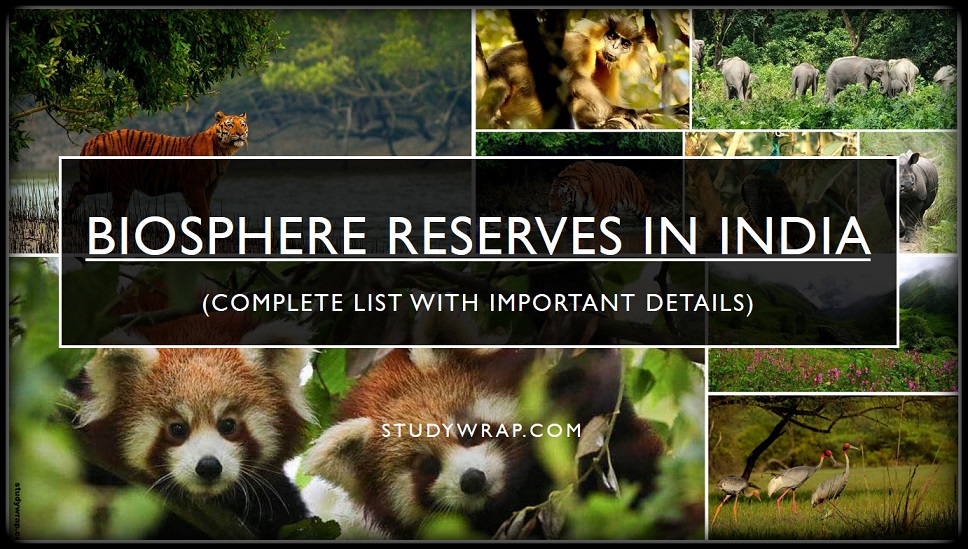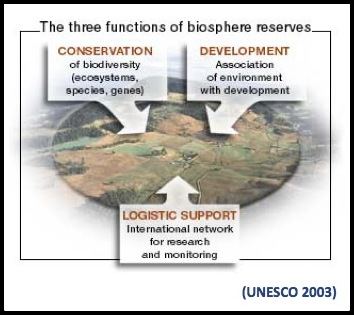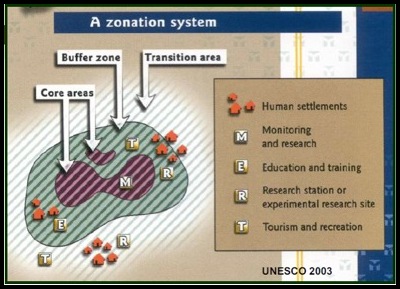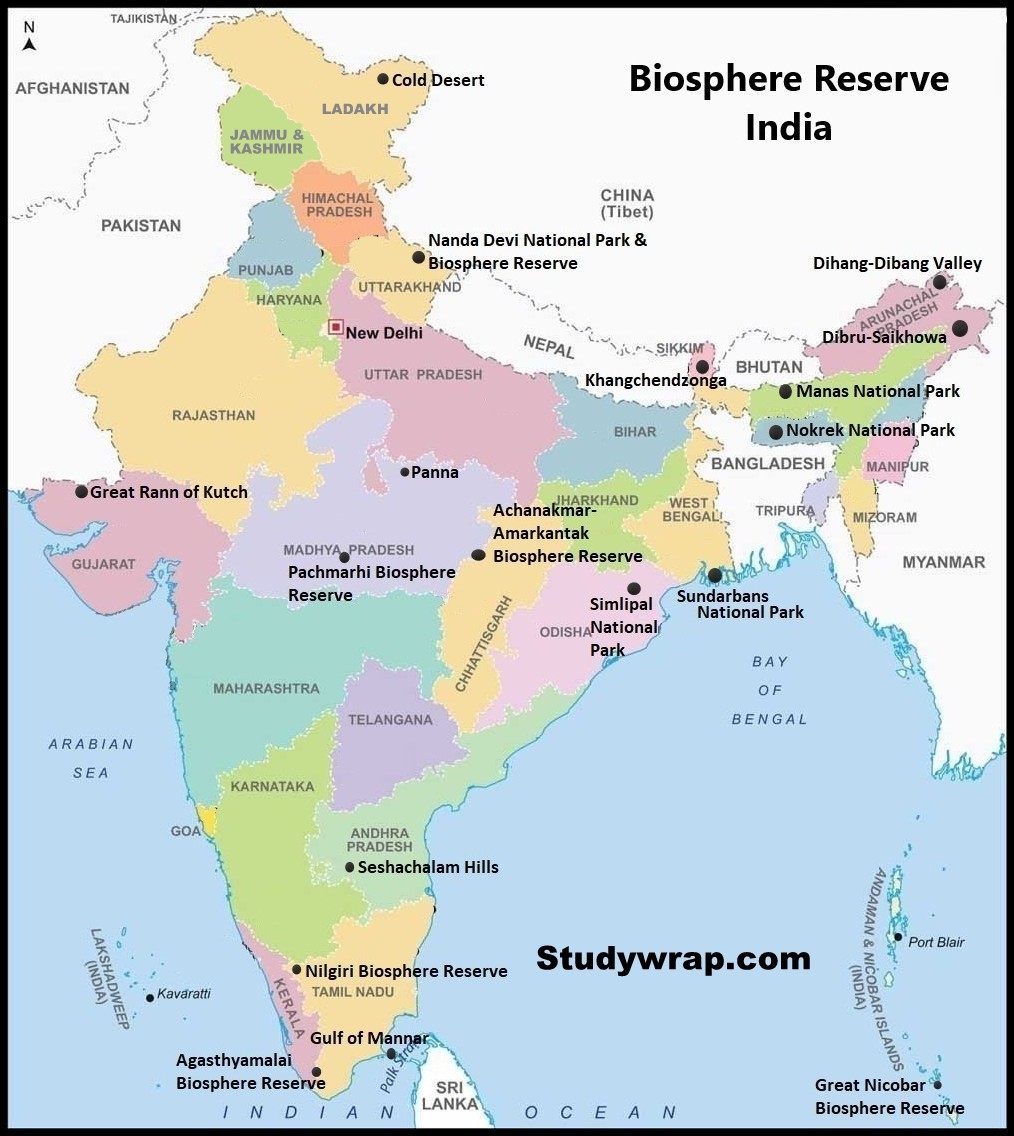Biosphere Reserves in India (Complete State-wise List)
Biosphere Reserves in India
Table of Contents
What are Biosphere Reserves (BR)?
· A biosphere Reserve is an area of land or water that is protected by law in order to support the conservation of ecosystems, as well as the sustainability of mankind’s impact on the environment.
· It is unique area and representative ecosystem of terrestrial and coastal areas which are internationally recognized within the framework of UNESCO’s Man and Biosphere (MAB) Program.
· The concept of Biosphere Reserves was launched in 1971 as a, part of United Nations Educational, Scientific and Cultural Organization (UNESCO)’s ‘Man and Biosphere Programme’.

Criteria for Designation of Biosphere Reserve
· A site must contain a protected and minimally disturbed core area of value of nature conservation.
· Core area must be a bio-geographical unit and should be large enough to sustain a viable populations representing all trophic levels.
· The involvement of local communities and use of their knowledge in biodiversity preservation.
· Areas potential for preservation of traditional tribal or rural modes of living for harmonious use of the environment.
Aim and Objectives of Biosphere Reserves
· Conserve representative samples of all ecosystem and habitat types.
· Provides long term in situ conservation of genetic biodiversity.
· Promote and facilitate basic and applied research and monitoring of wildlife.
· Promote mass education, awareness and capacity building.
· Promote appropriate sustainable management of natural resources.
· Dissemination of experience so as to promote sustainable development elsewhere.
· Biosphere management mandates people’s participation for conservation of natural resources and shopping of national landscape.
· Promoting sustainable development in communities of the surrounding region.
International Status of Biosphere Reserve
· The UNESCO has introduced the designation ‘Biosphere Reserve’ for natural areas to minimize conflict between development and conservation.
· Biosphere Reserves are nominated by national government which meets a minimal set of criteria under the Man and Biosphere Reserve Program of UNESCO.
· Globally, there are 686 biosphere reserves in 122 countries, including 20 transboundary sites. Distribution of the Biosphere Reserves across the World are as follows –
§ 79 sites in 29 countries in Africa
§ 33 sites in 12 countries in the Arab States
§ 157 sites in 24 countries in Asia and the Pacific
§ 302 sites in 38 countries in Europe and North America
§ 130 sites in 21 countries in Latin America and the Caribbean.
Man and Biosphere Programme
· It is an intergovernmental scientific programme, launched in 1971 by UNESCO, which aims to establish a scientific basis for the improvement of relationships between people and their environments.
· The MAB programme provides a unique platform for cooperation on research and development, capacity-building and networking to share information, knowledge and experience on three interlinked issues – biodiversity loss, climate change and sustainable development, thus promoting innovative approaches to economic development that are socially and culturally appropriate, and environmentally sustainable.
· There are total 11 biosphere reserves of India which have been recognized internationally under Man and Biosphere Reserve program –
1. Nilgiri (First to be included in MAB Program)
2. Gulf of Mannar
3. Sunderban
4. Nanda Devi
5. Nokrek
6. Pachmarhi
7. Similipal
8. Achanakmar – Amarkantak
9. Great Nicobar
10.Agasthyamala
11.Khangchendzonga (Added under MAB Program in 2018)
Zonation of Biosphere Reserves of India
· The purpose of the formation of the biosphere reserve is to conserve in situ all forms of life, along with its support system, in its totality, so that it could serve as a referral system for monitoring and evaluating changes in natural ecosystems. Biosphere Reserve of India are divided into 3 zones –

1. Core Areas
§ It is the most protected area of a biosphere reserve. It may contain endemic plants and animals.
§ A core zone is a protected region, like a National Park or Sanctuary/protected mostly under the Wildlife (Protection) Act, 1972. It is kept free from human interference.
2. Buffer Zone
§ Surrounds or is contiguous to the core area.
§ Activities are organized so they do not hinder the conservation objectives of the core area, but rather help to protect it in its natural condition.
§ It is used for cooperative activities such as restoration, limited tourism, fishing, grazing, etc. compatible with sound ecological practices.
§ Research and educational activities are to be encouraged.
3. Transition Zone or Area of Cooperation
§ It is the outermost part of the biosphere reserve. It is the zone of cooperation where human ventures and conservation are done in harmony.
§ It includes settlements, croplands, managed forests and areas for intensive recreation and other economic uses characteristics of the region to sustainably develop the area’s resources.
Interesting Facts about Biosphere Reserves in India
· There are 18 Biosphere Reserves in India. Of these, 11 are part of the World Network of Biosphere Reserves.
· First Biosphere Reserve – Nilgiri Biosphere Reserve (Est. 1986)
· Largest Biosphere Reserve – Gulf of Mannar
· Smallest Biosphere Reserve – Panna
· First Biosphere Reserve to be included in MAB Program – Nilgiri Biosphere Reserve
· Latest Biosphere Reserve added to List of MAB Program – Khangchendzonga (2018)
· India’s Only Mixed Site Conservation Site of Biosphere Reserve – Khangchendzonga

Complete State-wise List of Biosphere Reserves in India
· Presently, there are 18 notified biosphere reserves in India. 11 out of the 18 are a part of the World Network of Biosphere Reserves, based on the UNESCO Man and the Biosphere (MAB) Programme list.
|
Name |
State Location |
National Park/Sanctuaries |
Flora, Fauna & Rivers |
Other Details |
|
Nilgiri Biosphere Reserve |
Tamil Nadu, Kerala and Karnataka
Part of Waynad, Nagarhole, Bandipur and Mudumalai, Nilambur, Silent Valley |
National Parks – Aralam, Mudumalai, Mukurthi, Nagarhole, Bandipur and Silent Valley NP
Sanctuary – Wayanad WS, Sathyamangalam WS.
Tiger Reserve – Nagarahole TR, Bandipur TR, Mudumalai TR |
Flora – Forest Type – Moist Evergreen, Semi-Evergreen, Thorn, Savannah Woodland, Sholas and Grassland Endemic Flora – orchids species – Vanda, Liparis, Bulbophyllum, Spiranthes , Thrixspermum
Fauna – Endemic Fauna – Nilgiri tahr, Nilgiri langur, Lion – tailed macaque, Tiger
Rivers – Bhavani, Moyar, Kabini (tribuatries of Cauvery), Chaliyar, Punampuzha, etc.
|
Established year 1986
Type – Western Ghats
UNSECO World Heritage Site UNESCO Man & Biosphere Programme |
|
Nanda Devi National Park & Biosphere Reserve |
Uttarakhand
Parts of Chamoli District, Pithoragarh District & Bageshwar District |
National Parks – Nanda Devi NP Valley of Flowers NP
Sanctuary – Nanda Devi WS |
Flora – Forest Type – mixed temperate and subalpine Endemic Flora – Salep Orchid, Silver weed, Fairy candelabra, Fairy Primrose
Fauna – Endemic fauna – Himalayan tahr, Brown bear, Koklas pheasant, Snow Leopard, Himalayan Black Bear
Rivers – Rishi Ganga |
Established year 1988
Type – Western Himalayas UNSECO World Heritage Site
Part of UNESCO MAB Programme
Entire area is located within the Western Himalayas Endemic Bird Area (EBA).
|
|
Nokrek |
Meghalaya
Part of Garo Hills |
National Parks – Nokrek National Park |
Flora – Forest Type – Evergreen and semi-evergreen deciduous forests Endemic Flora – Grand rasamala, White meranti, Lali, Chempaka, Wild lemon
Fauna – Endemic Fauna – Stump tailed macaque, Pig-tailed macaque, Giant flying squirrel, Red panda, Asian elephant, Hoolocks
Rivers – Ganol, Dareng and Simsang
|
Established year 1988
Type – Eastern hills
UNESCO Man and Biosphere Programme |
|
Gulf of Mannar |
Tamil Nadu
Indian part of Gulf of Mannar extending from Rameswaram island in the North to Kanyakumari in the South of Tamil Nadu and Sri Lanka |
National Parks – Gulf of Mannar Marine National Park |
Flora – Forest Types – Tropical Dry Broad-leafed forest, seaweed communities, sea grass communities, coral reefs, salt marshes and mangrove forests. Endemic Flora – Morning glory, Jatropha, Halophila grass
Fauna – Endemic Fauna – Sea Cow, Sea Anemone, Sea fans, Dugong or sea cow |
Established year 1989
Type – Coasts
Part of UNESCO MAB Program
First marine Biosphere Reserve in India
Falls within the Indo-Malayan realm.
|
|
Sundarbans |
West Bengal
Part of delta of Ganges and Brahmaputra river system |
National Parks – Sundarbans NP
Sanctuary – Sundarbans West, Sundarbans South, Sundarbans East WS, Sajnakhali WS
Tiger Reserve – Sunderbans TR |
Flora – Forest Types – Tidal Swamp Forests, Saline Water Type Mixed Forests, Brackish Water Type Mixed Forests, Palm Swamp Type Endemic Flora – Sundari, Passur, Nypa
Fauna – Endemic Fauna – Royal Bengal tiger, Bengal monitor lizard, Salvator lizard Others – Gangetic dolphin, , estuarine crocodile, river terrapin, olive ridley turtle
Rivers – Meghna
|
Established year 1989
Type – Gangetic Delta
UNSECO World Heritage Site
UNESCO Man and Biosphere Programme |
|
Manas |
Assam
Part of Kokrajhar, Bongaigaon, Barpeta,Nalbari, Kamrup and Darrang Districts |
National Parks – Manas National Park
Tiger Reserve,
Elephant Reserve |
Flora – Forest Type – Semi Evergreen forest mixed moist & dry deciduous forests, alluvial grasslands, Eastern seasonal Swamp Forest, Cane and bamboo brakes Endemic Flora – Catechu tree, Sissoo, White siris
Fauna – Endemic Fauna – Golden langur, red panda, Asiatic Elephant, Tiger, Assam roofed turtle, Hispid hare, pygmy hog
Rivers – Manas-Beki
|
Established year 1989
Type – Eastern hills
UNSECO World Heritage Site
UNESCO Man and Biosphere Programme |
|
Great Nicobar Biosphere Reserve |
Andaman and Nicobar Islands
Southernmost islands of Andaman and Nicobar Islands |
National Parks – Campbell Bay NP, Galathea Bay NP
Sanctuary – Galathea Bay WLS |
Flora – Forest Type – Tropical and Sub-tropical Moist Broad-leafed Forest Endemic Flora – Screw pine, Nipa palm, Ceylon iron wood
Fauna – Endemic Fauna – Saltwater crocodile, Nicobar scrubfowl, edible-nest swiftlet , Nicobar long-tailed macaque, giant leatherback sea turtle, Malayan box turtle, Nicobar tree shrew, reticulated python, giant robber crab
|
Established year 1989
Type – Islands
UNESCO Man and Biosphere Programme
Indira Point – southernmost point of Republic of India |
|
Simlipal |
Odisha
Part of Mayurbhanj district |
National Parks – Simplipal NP
Sanctuary – Simlipal WLS, Kuldiha, Hadgarh WLS
Tiger Reserve – Part of Mayurbhanj
Elephant Reserve |
Flora – Forest Type – Northern Tropical Semi Evergreen Forests, Northern Tropical Moist Deciduous Forests, Dry Deciduous Hill Forests, High Level Sal Forest, Grassland and Savannah Endemic Flora – Coix grass
Fauna – Endemic Fauna – Red breasted falconet, Slender billed scimitar babbler, Ruddy mongooseGaur, royal Bengal tiger, elephant
Rivers – Budhabalanga, Palpala Bhandan, Kharkai River and Deo
|
Established year 1994
Type – Deccan Peninsula
UNESCO Man and Biosphere Programme
The biosphere reserve has the largest zone of Sal in all of India. |
|
Dibru-Saikhowa |
Assam
Part of Dibrugarh and Tinsukia districts |
National Parks – Dibru-Saikhowa National Park |
Flora – Forest Type – semi wet evergreen forests, tropical moist deciduous forest, bamboo, swamp forests, cane brakes and grasslands. Endemic Flora – Rauvolfia (Sarpagandhi), Benteak, Livistona (orchid)
Fauna – Endemic Fauna – Golden langur, Bengal tiger, hoolock gibbons, leopards, clouded leopard, jungle cat, sloth bear, dhole, small Indian civet, Malayan giant squirrel, Chinese pangolin, Gangetic dolphin, Lesser Adjutant Stork, spotted-billed Pelican, White bellied Heron, Pallas’s Fish Eagle
Rivers – Dibru, Brahmaputra
|
Established year 1997
Type – Eastern Hills |
|
Dihang-Dibang |
Arunachal Pradesh
Part of Siang and Dibang Valley |
National Parks – Mouling National Park
Sanctuary – Dibang Wildlife Sanctuary |
Flora – Forest Type – sub-tropical broad-leaved, sub-tropical pine, temperate broad-leaved, temperate conifer, sub-alpine woody shrub, alpine meadow, bamboo brakes & grassland. Endemic Flora – Tree fern, Begonia, Lady’s slipper orchid
Fauna – Endemic Fauna – Mishmi Takin, Musk Deer, red goral, red panda, Asiatic black bear, Green pit viper
Rivers – Dehang, Debang & their tributaries
|
Established year 1998
Type – Eastern Himalaya |
|
Pachmarhi Biosphere Reserve |
Madhya Pradesh
Parts of Betul District, Hoshangabad District and Chhindwara District |
National Parks – Satpura National Park
Sanctuary – Bori Sanctuary, Pachmarhi Sanctuary
Tiger Reserve – Satpura Tiger Reserve |
Flora – Forest Type – moist deciduous, dry deciduous, central Indian sub-tropical hill forest. Endemic Flora – Sal tree, Selaginella fern, Palimorpha bamboo
Fauna – Endemic Fauna – Barasinga, Red jungle fowl, Giant squirrel, flying squirrel, Chinkara, nilgai, wild dogs, the Indian wolf, Bison.
Rivers – Denwa
|
Established year 1999
Type – Semi-Arid
UNESCO Man and Biosphere Programme
Recognized as “Genetic Express Highway” linking two biological hot spots of the country viz. Eastern Himalayas & Western Ghats.
|
|
Khangchend-zonga |
Sikkim
Parts of Kangchenjunga |
National Parks – Khangchendzonga NP |
Flora – Forest Type – Sub-tropical broad leaved hill forest, Himalayan wet temperate forest, and temperate broad leaved forest, mixed coniferous forest, sub-alpine a forests and dry alpine forest. Endemic Flora – Anemone, Uvaria, Sikkim Rhododendron, Sikkim Mahonia
Fauna – Endemic Fauna – Red Panda, Snow Leopard, Himalayan Black Beer & herbivores species of Musk deer, Great Tibetan Sheep, Blue Sheep, Boral and Barking Deer, Monal Pheasants, Tragopan Pheasants & Blood Pheasants (the State Bird)
Rivers – Teesta
|
Established year 2000
Type – East Himalayas
UNSECO World Heritage Site (Only mixed site in India)
India’s first Mixed Heritage Site
UNESCO Man and Biosphere Programme |
|
Agasthyamalai Biosphere Reserve |
Kerala, Tamil Nadu
Neyyar, Peppara and Shenduruny Wildlife Sanctuary and their adjoining areas |
Sanctuary – Neyyar WLS, Peppara WLS, Shenduruny Wildlife Sanctuary
Tiger Reserve – Kalakad Mundanthurai TR |
Flora – Forest Type – thorn, moist deciduous and semi-evergreens Endemic Flora – Rudraksha tree, Black plums, Gaub tree, Wild Dhaman
Fauna – Endemic Fauna – Lion-tailed macaque, Slender loris, Great pied hornbill, Asian elephant, tiger and Nilgiri Tahr
Rivers – Tambraparani |
Established year 2001
Type – Western Ghats
UNESCO Man and Biosphere Programme
Home to the Kanikaran one of the oldest surviving ancient tribes in the world.
|
|
Achanakmar-Amarkantak Biosphere Reserve |
Madhya Pradesh, Chhattisgarh
Part of Annupur, Dindori and Bilaspur districts |
Sanctuary – Achanakmar Wildlife Sanctuary |
Flora – Forest Type – Tropical deciduous vegetation. Further classified into Northern Tropical Moist Deciduous and Southern Dry Mixed Deciduous forests Endemic Flora – Several thallophyte, bryophyte, pteridophyte, gymnosperm, and angiosperm species found.
Fauna – Endemic Fauna – Four-horned antelope, Indian wild dog, Sarus crane, White-rumped vulture, Philautus sanctisilvaticus (Sacred grove bush frog), Tigers, panthers, Chitals, blackbuck, giant squirrels etc
Rivers – Narmada, Johilla and Sone, Ama Nallah
|
Established year 2005
Type – Maikala Hills
UNESCO Man and Biosphere Programme |
|
Great Rann of Kutch |
Gujarat
Part of Kutch, Rajkot, Surendranagar and Patan Districts |
In Kutch Area Sanctuary – Indian Wild Ass Sanctuary, Kutch, Desert Wildlife Sanctuary, Narayan Sarovar Sanctuary, Kutch Bustard Sanctuary |
Flora – Two major ecosystems – Great Rann of Kachchh (GRK) and Little Rann of Kachchh (LRK) Forest Type – mixed scrub, thorn, savannah in GRK. Mangroves in the eastern border of Banni grassland in GRK.
Fauna – Endemic Fauna – Indian wild ass, Greater and Lesser Flamingos
Rivers – Luni, Rupen, West Banas drains into the area
|
Established year 2008
Type – Desert
Banni grasslands – (Rann of Kutch) the largest natural grassland in the Indian subcontinent, inhabited by Maldhari pastoralists.
|
|
Cold Desert |
Himachal Pradesh
Pin Valley National Park and surroundings; Chandratal and Sarchu & Kibber Wildlife Sancturary |
National Parks – Pin Valley NP
Sanctuary – Chandratal WLS, Sarchu WLS, Kibber WLS |
Flora – Forest Type – Herbs, shrub species Endemic Flora – Anemone, Uvaria, Sikkim Rhododendron, Sikkim Mahonia
Fauna – Endemic Fauna – Snow Leopard, Tibetan gazzle, red fox, weasel, marmot, griffon, lammergeyer, golden eagle, snow cock, brown and black bear, ibex etc.
Rivers – Pin, Chandrabhaga, Spiti
|
Established year 2009
Type – Western Himalayas
Lie in the rain shadow of the Himalayas. |
|
Seshachalam Hills |
Andhra Pradesh
Seshachalam Hill Ranges covering parts of Chittoor and Kadapa districts |
National Parks – Srivenkateshwara NP
Sanctuary – Sri Venkateswara WLS |
Flora – Forest Type – Both dry and Moist deciduous Type Endemic Flora – Red Sanders and Slender Loris
Fauna – Endemic Fauna – Jungle cat, Great Mouse Deer, golden Gekos, Slender Loris, Indian Giant Squirrel, Mouse deer, Golden Gecko, Yellow throated Bulbul |
Established year 2010
Type – Eastern Ghats
Large reserves of Red Sandal wood |
|
Panna |
Madhya Pradesh
Part of Panna District and Chhatarpur District |
National Parks – Panna NP
Tiger Reserve |
Flora – Forest Type – Southern Tropical Dry Deciduous Dry Teak Forest, Northern Tropical Dry Deciduous Mixed Forest, Dry Deciduous Scrub Forest, Boswellia Forest, Dry Bamboo Brakes, Anogeissus pendula Forest. Endemic Flora – Panna represents the northern boundary of the natural distribution of teak, and the eastern limits of teak-kardhai mixed forests.
Fauna – Endemic Fauna – Tiger, leopard, chital, chinkara, Nilgai, tree shrew, long snouted crocodile, mugger, sambhar and sloth bear
Rivers – Ken
|
Established year – 2011
Type – Catchment Area of the Ken River
Links the eastern and western wildlife populations of the Vindhyan ranges. |
Potential sites for Biosphere Reserves in India
· The following are the potential sites for Biosphere Reserves as selected by Ministry of Forests and Environment –
1. Abujmarh, Chhattisgarh
2. Andaman and Nicobar, North Islands
3. Chintapalli, Visakhapatnam, Andhra Pradesh
4. Kanha, Madhya Pradesh
5. Kovalam, Kerala
6. Lakshadweep Islands, Lakshadweep
7. Little Rann of Kutch, Gujarat
8. Phawngpui (Blue Mountain), Mizoram
9. Namdapha, Arunachal Pradesh
10. Singhbhum, Jharkhand
11. Tawang and West Kameng, Arunachal Pradesh
12. Thar Desert, Rajasthan
13. Tadoba National Park and Sanjay Gandhi National Park, Maharashtra
So, this was all about the Complete List of Biosphere Reserves in India. If you want to read more about the Wildlife of India, you can click here to read more – Wildlife of India.
If you have like our post than do subscribe our Newsletter and Share it with your Friends and Family and like Our Facebook Page. Sharing is CaringJ.

